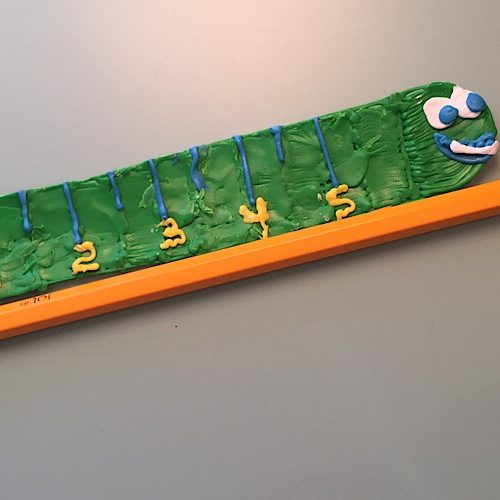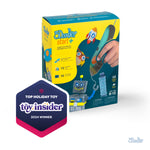MATH: Doodle-Inchworm (Measurement)
In this activity, students will work in pairs to practice measuring objects in inches using a doodled inchworm ruler. Students will then work in larger groups to place doodled inchworm rulers together to measure larger objects.

KnowledgeStudents havepracticed with the 3Doodler.
had practice drawing straight lines, outlines and fill with the 3Doodler.
practice measuring objects in inches.
practiced with the 3Doodler.
had practice drawing straight lines, outlines and fill with the 3Doodler.
practice measuring objects in inches.
ObjectivesStudents willuse a 3Doodler to doodle a 5-inch ruler.
use doodled rulers to measure objects on the Inchworm Measurement Worksheet.
weld rulers together to explore and measure larger objects in the classroom.
use a 3Doodler to doodle a 5-inch ruler.
use doodled rulers to measure objects on the Inchworm Measurement Worksheet.
weld rulers together to explore and measure larger objects in the classroom.
MaterialsStudents will need3Doodler (1 per pair)
Doodle Inchworm Stencil (1 per pair)
Inchworm Measurement Worksheet (1 per pair)
pencil (1 per student)
3Doodler (1 per pair)
Doodle Inchworm Stencil (1 per pair)
Inchworm Measurement Worksheet (1 per pair)
pencil (1 per student)
Lesson PlanInstructions
Step 1Whole Group: Read the book Inch by Inch, and afterwards discuss the types of things that the inchworm measured. Ask what unit of measurement was used (inches). Have students review the numbers on a 12-inch ruler.
Step 2Share the goal: During this session, students will work in pairs to doodle their own inchworm-rulers using a 3Doodler.
Step 3Model how to doodle onto the Doodle Inchworm Stencil. Explain how the stencil will be used to doodle an inchworm-ruler by outlining first, then segmenting larger fill sections into smaller segments, followed by filling each segment using a back and forth motion with the 3Doodler.
*See Resource Section
Step 4Show students how to peel the plastic off of the stencil once dry, then show them how to line up the doodled-inchworm with the stencil to doodle in the lines and numbers in the proper place. Let the students know that they will be split into pairs, and that each student will Doodle portions of the inchworm ruler.
Step 5Hand out Doodle Inchworm Stencils and one 3Doodler pen to each pair of students.
*The doodling portion of this lesson is best handled in a small group center or with parent-volunteers or aids to assist the teacher.
Step 6Show students the objects on the Inchworm Measurement Worksheet. Have them guess how long each one is, then have them work in pairs to measure the objects on the worksheet with their Doodled inchworm rulers to see if they are right.
Step 7As students measure, move through the class to assist and assess. Ask which object is longest and shortest. Compare the length of the measured objects.
Step 8After reviewing their results, suggest that there are objects larger than 5 inches in the classroom. How can they use their inchworm-rulers to measure them?
*Students may work with another group or groups to weld their rulers end-to-end. Inchworms' heads and tails must overlap for accuracy (model how to do this to the class).
Whole Group: Read the book Inch by Inch, and afterwards discuss the types of things that the inchworm measured. Ask what unit of measurement was used (inches). Have students review the numbers on a 12-inch ruler.
Share the goal: During this session, students will work in pairs to doodle their own inchworm-rulers using a 3Doodler.
Model how to doodle onto the Doodle Inchworm Stencil. Explain how the stencil will be used to doodle an inchworm-ruler by outlining first, then segmenting larger fill sections into smaller segments, followed by filling each segment using a back and forth motion with the 3Doodler.
*See Resource Section
Show students how to peel the plastic off of the stencil once dry, then show them how to line up the doodled-inchworm with the stencil to doodle in the lines and numbers in the proper place. Let the students know that they will be split into pairs, and that each student will Doodle portions of the inchworm ruler.
Hand out Doodle Inchworm Stencils and one 3Doodler pen to each pair of students.
*The doodling portion of this lesson is best handled in a small group center or with parent-volunteers or aids to assist the teacher.
Show students the objects on the Inchworm Measurement Worksheet. Have them guess how long each one is, then have them work in pairs to measure the objects on the worksheet with their Doodled inchworm rulers to see if they are right.
As students measure, move through the class to assist and assess. Ask which object is longest and shortest. Compare the length of the measured objects.
After reviewing their results, suggest that there are objects larger than 5 inches in the classroom. How can they use their inchworm-rulers to measure them?
*Students may work with another group or groups to weld their rulers end-to-end. Inchworms' heads and tails must overlap for accuracy (model how to do this to the class).
Wrap Up
Assessment
Possible Extensions
Resources
Vocabulary
acting - the art or practice of representing a character before an audience.
collaboration - to work jointly with others or together especially in an intellectual endeavor.
color - the quality of an object or substance with respect to light reflected by the object, usually determined visually by measurement of hue, saturation, and brightness of the reflected light; saturation or chroma; hue.
counting - to indicate or name by units or groups so as to find the total number of units involved.
drawing - the art or technique of representing an object or outlining a figure, plan, or sketch by means of lines.
inch - a unit of length, 1/12 (0.0833) foot, equivalent to 2.54 centimeters.
measurement - the act or process of measuring; a figure, extent, or amount obtained by measuring.
number - a unit belonging to an abstract mathematical system and subject to specified laws of succession, addition, and multiplication.
one-to-one correspondence -
problem-solving - the process or act of finding a solution to a problem.
writing - any written or printed paper, as a document or deed.
Educational Standards
Order three objects by length; compare the lengths of two objects indirectly by using a third object.
Students will use doodled inchworm rulers to measure and compare the length of objects.
Express the length of an object as a whole number of length units, by laying multiple copies of a shorter object (the length unit) end to end; understand that the length measurement of an object is the number of same-size length units that span it with no gaps or overlaps.
Students will weld inchworm rulers together to create to measure longer objects.
Decompose (break down) a larger problem into smaller sub-problems with teacher guidance or independently.
Students will break down the process of comparing the lengths of objects into the process of doodling, measurement and discussion.
Use technology to seek feedback that informs and improves their practice and to demonstrate their learning in a variety of ways.
Students will use the 3Doodler to create doodled rulers to explore and compare the length of objects in the classroom.
Exhibit a tolerance for ambiguity, perseverance and the capacity to work with open-ended problems.
Students will demonstrate willingness and competency with how to measure longer objects using the 5-inchworm ruler.
Create original works or responsibly repurpose or remix digital resources into new creations.
Students will use a 3Doodler to creatively reinterpret a traditional ruler into a doodled inchworm ruler.
Use collaborative technologies to work with others, including peers, experts or community members, to examine issues and problems from multiple viewpoints.
Students will seek feedback from peers throughout the design and counting process.





